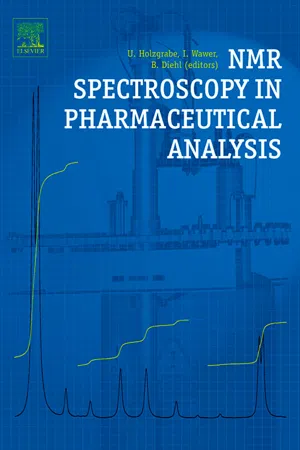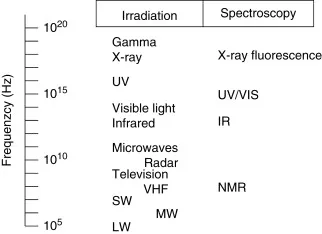![]()
Part I. Fundamentals and Techniques
![]()
Chapter 1. Principles in NMR Spectroscopy
More than any other analytical method the nuclear magnetic resonance (NMR) spectroscopy provides information about the chemical structure and the dynamics of organic molecules. The interpretation of the NMR data depends on a minimum amount of basic information that will be provided in this chapter. For a better appliance, these basics of one- and two-dimensional NMR techniques are demonstrated by means of practical examples.
1. Short History
Nuclear magnetic resonance (NMR) spectroscopy has been developed to be the most powerful analytical method. It allows the visualisation of single atoms and molecules in various media in solution as well as in solid state. NMR is non-destructive and gives molar response that allows structure elucidation and quantification simultaneously. Magnetic interactions between NMR-active nuclei along covalent bindings result in spin–spin (nJ-) couplings. Through-space interactions can be detected using the nuclear Overhauser effect (NOE). Both interactions enable three-dimensional structure elucidation.
The steady progress of NMR spectroscopy can clearly be seen in the list of Noble Prize winners. In 1944 the first Nobel Prize in physics was awarded to Rabi for the development of a resonance method that enables recording of the magnetic properties of atomic nuclei. Bloch and Purcell received the Prize in 1952 as a tribute to the first practical NMR experiments, which were carried out independently by both of them in 1945 at different places. By then, the NMR spectroscopy started to become more than a physical experiment. By the discovery of the “chemical shift” the method has become a tool for chemists in structure elucidation. The first useful NMR spectrometers were continuous wave (CW) instruments using permanent or electromagnets. Their utility came to an end with the upcoming superconductor magnets in the 1970s. However, only since Ernst developed the basics of the Fourier transformation (FT) method, the foundation of the modern NMR spectroscopy methods was laid. Since NMR spectroscopy was by then a domain of physicians, Ernst was the first chemist in the list of Nobel Prize winners in 1991. A decade later, Wüthrich was the second honoured chemist. He received the Prize in 2002 for the elucidation of three-dimensional structures of macromolecules. The NMR technique has become an important tool in other scientific fields, especially in medicine. It is not surprising that only one year later the NMR technique was honoured again, and the Nobel Prizes were awarded to Lauterbach and Mansfield for their research in magnetic resonance imaging. Rightly, the NMR community expects further Prizes in one of the widespread application areas of NMR spectroscopy in the future.
This book shall give its readers an overview about the NMR techniques used in pharmaceutical applications and help the method to become accepted as the most significant analytical tool in the pharmacopoeia. It is written for pharmacists and chemists and cannot be an NMR textbook. A list of recommended literature is given in references,[1–7] including basic information on NMR imaging.[8] Even in the World Wide Web very useful information is available to understand the basics of NMR spectroscopy.[9] However, a short summary of some basics and important principles of NMR is given in this chapter, using the example of a full structure elucidation on rifamycin and its derivatives by one- and two-dimensional 1H- and 13C NMR techniques. This substance was chosen rather for practical reasons, as it is one of the drugs routinely analysed in our NMR laboratory. However, rifamycin shows a wide variety of interesting substructures and is therefore most suited to illustrate the basics of NMR spectroscopy.
2. The NMR Experiment
Within the group of spectroscopic methods the NMR spectroscopy uses the lowest irradiation energy for excitation (Figure 1). Owing to the low-energy level excitation, relaxation and sensitivity of NMR spectroscopy are specifically different from other spectroscopic methods.
Figure 1. Energy levels of different spectroscopic methods.
2.1. Excitation, relaxation and sensitivity
Molecular spectroscopy is a subject of quantum physics. Excitation of molecular movement or vibration as used with infrared (IR) spectroscopy or the excitation of an electron in a higher π-orbital as used for ultraviolet/visible (UV/VIS) spectroscopy is possible in a normal surrounding. The excitation, in principle, requires two different energy levels: for IR and UV spectroscopy, respectively, these conditions are given at any place without the need of technical resources. However, this is not the case in NMR spectroscopy. The irradiated energy can only interact with the nuclear spin quantum status, if an artificially produced magnetic field affects the generation of two different energy levels.
A proton is a charged elementary particle. Similar to a spinner, its movement results in the generation of a magnetic field and therefore protons can be described as elementary magnets. The spin quantum number of a proton is 1/2. The possible angular impulse quantum numbers mI therefore restrict the different energy states to two mI = ±1/2. Without a magnetic field (B0 = 0) both the quantum states are equivalent; theref...

